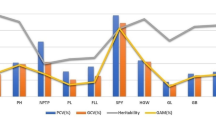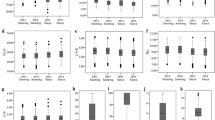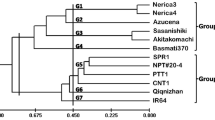Abstract
Identifying the best performing hybrid without a field test was essential to save resources and time. In this study, the genetic divergence was estimated using morphological and expressed sequence tag (EST)-derived simple sequence repeats (SSR) markers. Cluster analysis showed that APMS6A and RPHR 1005 belong to groups I and II, respectively, and the hybrid combination recorded the highest mean grain yield of 32.25 g among generated 40 \(\hbox {F}_{1}\hbox {s}\) with standard heterosis of 8.4% over hybrid check, KRH2. The coefficient of marker polymorphism (CMP) value was calculated based on EST-SSR markers; it ranged from 0.40 to 0.80, and a higher CMP value of 0.80 was obtained for the parental combination APMS6A \(\times \) RPHR1005. We predicted heterosis for 40 \(\hbox {F}_{1}\hbox {s}\) based on correlation between CMP and standard heterosis in different traits with standard varietal and hybrid checks indicating positive correlation and significant value for grain yield per plant (\(r=0.58\)**), productivity per day (\(r=0.54\)**), productive tillers (\(r=0.34\)*) and panicle weight (\(r=0.42\)**). This study revealed that the relationship of molecular marker heterozygosity, along with the combining ability, high mean value of different traits, grouping of parental lines based on morphological and molecular characterization is helpful to identify heterotic patterns in rice.




Similar content being viewed by others
References
Chand S. P., Roy S. K. and Senapathi B. K. 2005 Genetic divergence in Aman rice under semi deep rainfed condition. Crop Res. – Hissar 30, 46–49.
Chaturvedi H. P. and Maurya D. M. 2005 Genetic divergence analysis in rice (Oryza sativa L.). Adv. Plant Sci. 18, 349–353.
Chen X. S., Jenny K. H., Xu Y., Cho X. G. and Mc Couch S. R. 1997 Development of a microsatellite framework map providing genome wide coverage in rice (Oryza sativa L.). Theor. Appl. Genet. 95, 553–567.
Cho Y. I., Park C. W., Soon W. K., Joong H. C., Ji H. S., Park K. J. et al. 2004 Key DNA markers for predicting heterosis in \(\text{ F }_{1}\) hybrids of Japonica rice. Breed. Sci. 54, 389–397.
DeWoody J. A., Honeycutt R. L. and Skow L. C. 1995. Microsatellite markers in white-tailed deer. J. Hered. 86, 317–319.
Hallauer A. R., Russell W. A. and Lamkey K. R. 1988 Corn breeding. Agronomy monograph 18. In Corn and corn improvement, 3rd ed. (ed. G. F. Sprague and J. W. Dudley), pp. 463–564. American Society of Agronomy, Madison.
Hedge S. G. and Patil C. S. 2000 Genetic divergence in rainfed rice. Karnataka J. Agric. Sci. 13, 549–553.
Jaikishan I., Rajendrakumar P., Ramesha M. S., Viraktamath B. C., Balachandran S. M., Neeraja C. N. et al. 2010 Prediction of heterosis for grain yield in rice using ‘key’ informative EST-SSR markers. Plant Breed. 129, 108–111.
Jones J. W. 1926. Hybrid vigor in rice. J. Am. Soc. Agron. 18, 423–428.
Joshi B., Singh H. and Pandey M. P. 2004 Study of heterosis and inbreeding depression in rice (Oryza sativa L.). Oryza 41, 64–67.
Lee M., Godshalk E. B., Lamkey K. R. and Woodman W. L. 1989 Association of restriction length polymorphism among maize inbreds with agronomic performance of their crosses. Crop Sci. 29, 1067–1071.
Madhavilatha L., Sekhar M. R., Suneetha Y. and Srinivas T. 2005 Studies on genetic divergence and isozyme variability in rice (Oryza sativa L.). Res. Crops 6, 527–534.
Mahalanobis P. C. 1936 On the generalized distance in statistics. Proc. Natl. Inst. Sci. India 2, 49–55.
Mathew L., Babu R. C., Souframanien J., Chezian P., Shanmugasundaram P., Nagarajan P. et al. 2000 DNA polymorphism among rice (Oryza sativa L.) accessions differing in drought tolerance. J. Plant Biol. 27, 145–152.
Melchinger A. E. and Gumber R. K. 1998 Overview of heterosis and heterotic groups in agronomic crops. In Concepts and breeding of heterosis in crop plants, pp. 29–44. Crop Science Society of America, USA.
Melchinger A. E., Lee M., Lamkey K. R. and Woodman W. L. 1990 Genetic diversity for restriction fragment length polymorphisms: relation to estimated genetic effects in maize inbreds. Crop Sci. 30, 1033–1040.
Mundhe B. S., Jundhale N. D. and Bendale V. W. 2006 Genetic divergence in midlate genotypes of rice. J. Maharashtra Agric. Univ. 31, 21–23.
Rao C. R. 1952 Advanced statistical methods in biometrical research. pp. 357–363. John Wiley, New York.
Rohlf F. J. 1998 NTSYS-pc: numerical taxonomy and multivariate analysis system, version 2.02. Exeter Software, Setauket, NY.
Schut J. W., Qi X. and Stam P. 1997 Association between relationship AFLP markers, pedigree data and morphological traits in barley. Theor. Appl. Genet. 95, 1161–1168.
Smith J. S. C. and Smith O. S. 1989 Comparison of heterosis among hybrids as a measure of relatedness with that to be expected on the basis of pedigree. Maize Genet. Coop. Newsl. 63, 86–87.
Smith O. S., Smith J. S. C., Bowen S. L., Tenborg R. A. and Wall S. J. 1990 Similarities among a group of elite maize inbreds as measured by pedigree, F1 grain yield, grain yield heterosis and RFLPs. Theor. Appl. Genet. 80, 833–840.
Stuber C. W., Lincoln S. E., Wolff D. W., Helentjaris T. and Lander E. S. 1992 Identification of genetic factors contributing to heterosis in a hybrid from elite maize inbred lines using molecular markers. Genetics 132, 823–839.
Tanksley S. D., Ganal M. W., Prince J. P., de Vincente M. C., Bonierble M. W., Broun P. et al. 1992 High density molecular linkage maps of the tomato and potato genomes. Genetics 132, 1141–1160.
Wang X., Li L., Yang Z., Zheng X., Yu S., Xu C. et al. 2016 Predicting rice hybrid performance using univariate and multivariate GBLUP models based on North Carolina mating design II. Hereditas 118, 302–310.
Yuan L. P., Virmani S. S. and Mao C. X. 1989 Hybrid rice–achievements and future outlook. In Progress in irrigated rice research (S. S. Viramani, C. X. Mao and B. Hardy), pp. 219–235. IRRI, Manila.
Zha R. 2008 Prediction of hybrid grain yield performances in Indica Rice (Oryza sativa L.) with effect increasing loci. Mol. Breed. 22, 467–476.
Zhang T., Ni-xian L., Jiang K. F., Yang Q. H., Yang L., Wan X. Q. et al. 2010 Correlation between heterosis and genetic distance based on molecular markers of functional genes in rice. Rice Sci. 17, 1–7.
Zhang Q., Zhou Z. Q., Yang G. P., Xu C. G., Liu K. D., Saghai Maroof M. A. et al. 1995 Molecular marker heterozygosity and hybrid performance in indica and japonica rice. Theor. Appl. Genet. 93, 1218–1224.
Zhang Q. Y., Gao J., Yane S. H., Raab R., Saghai Maroof M. A. and La B. 1994 A diallel analysis of heterosis in elite hybrid rice based on RFLPs and microsatellites. Theor. Appl. Genet. 89, 185–192.
Zhang Y., Liu T., Meyer C. A., Eeckhoute J., Johnson D. S., Bernstein B. E. et al. 2008 Model-based analysis of ChIP-Seq (MACS). Genome Biol. 9, 137.
Author information
Authors and Affiliations
Corresponding author
Additional information
Corresponding editor: Manoj Prasad
Rights and permissions
About this article
Cite this article
Pavani, M., Sundaram, R.M., Ramesha, M.S. et al. Prediction of heterosis in rice based on divergence of morphological and molecular markers. J Genet 97, 1263–1279 (2018). https://doi.org/10.1007/s12041-018-1023-8
Received:
Revised:
Accepted:
Published:
Issue Date:
DOI: https://doi.org/10.1007/s12041-018-1023-8




